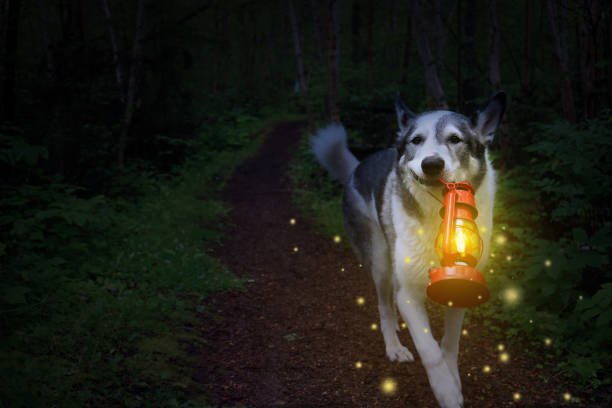
You might have probably heard somewhere that dogs have remarkable night vision, but can dogs see properly in the dark? Many dog owners tend to leave lights on for their furry friends when they are away at night, and they may even feel guilty if they accidentally leave their dogs in the dark. However, most dogs probably don’t mind being in the dark. Your dog’s ability to see in the dark is more advanced than you may realise.
Can Dogs See in the Dark?
Compared to humans, canines can see much better in low-light conditions; their eyes can take in small amounts of light and process images that humans would never see in the dark. However, dogs’ ability to see in low light doesn’t mean they can see in absolute darkness. A nightlight, streetlight, flashlight, or even the moon and stars can provide enough light for dogs to see almost as well as in bright sunlight.
How Dogs See in Low Light Conditions
Looking at just our meat eye, our dog’s eye may seem much more like the eye of a human. However, there are differences in the structure of a dog’s eye that give them superior night vision.
Both human and canine eyes work similarly in receiving images. Light enters the eye through the cornea and bends the light to help focus the image. The amount of light passing through the pupil depends on the size of the pupil. The muscles in the iris control the size of the pupils depending on the light conditions. A dog’s pupil opens wider than a human’s, allowing more light to enter. Light passes through the eye’s lens, which is responsible for focusing images at different distances. A dog’s lens is closer to the retina than a human’s, making images brighter.
Afterwards, the light hits the retina, where the rods and cones process the image and send signals to the brain. Rods are responsible for processing images in low light, while cones are responsible for colour vision and are less sensitive to light than rods. Compared with humans, our canine retina has many more rods than cones in its eyes, which is why dogs do not see colours as they appear in reality, but they can see images much clearer in low light.
All dogs have a feature in their eyes that we humans lack: mirror-like tissue in the back of their eyes called the tapetum lucidum. This feature gives the retina an extra opportunity to process the light that has entered the eye. The tapetum, I.e., what makes our dogs’ eyes glow in the dark when you take a flash photo or look at your dog’s eyes in the dark, helps scatter light, so these images may not be as clear as they would be in bright daylight.
What should you do if your dog has poor night vision?
Aside from dogs having superior night vision compared to humans, certain breeds of dogs have better night vision than others. If your dog has difficulty seeing in the dark, it could be an eye-related issue. If your dog previously had no trouble seeing in low-light conditions but is now struggling, it might indicate a vision problem that requires immediate attention.
As dogs age, they may experience vision loss; at first, you may notice this loss more at night than during the day due to age-related eye changes, such as lenticular sclerosis and cataracts, which can limit their eyesight, especially in dim light. Remember to contact your vet if your dog’s vision changes. They can identify the cause and provide treatment to prevent blindness.
Leave a Reply